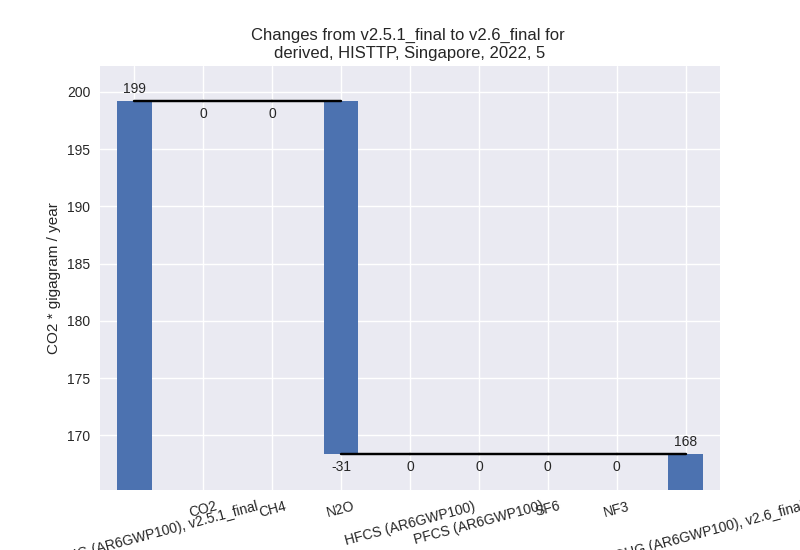Changes in PRIMAP-hist v2.6_final compared to v2.5.1_final for Singapore
2024-09-24
Johannes Gütschow
Change analysis for Singapore for PRIMAP-hist v2.6_final compared to v2.5.1_final
Overview over emissions by sector and gas
The following figures show the aggregate national total emissions excluding LULUCF AR6GWP100 for the country reported priority scenario. The dotted linesshow the v2.5.1_final data.
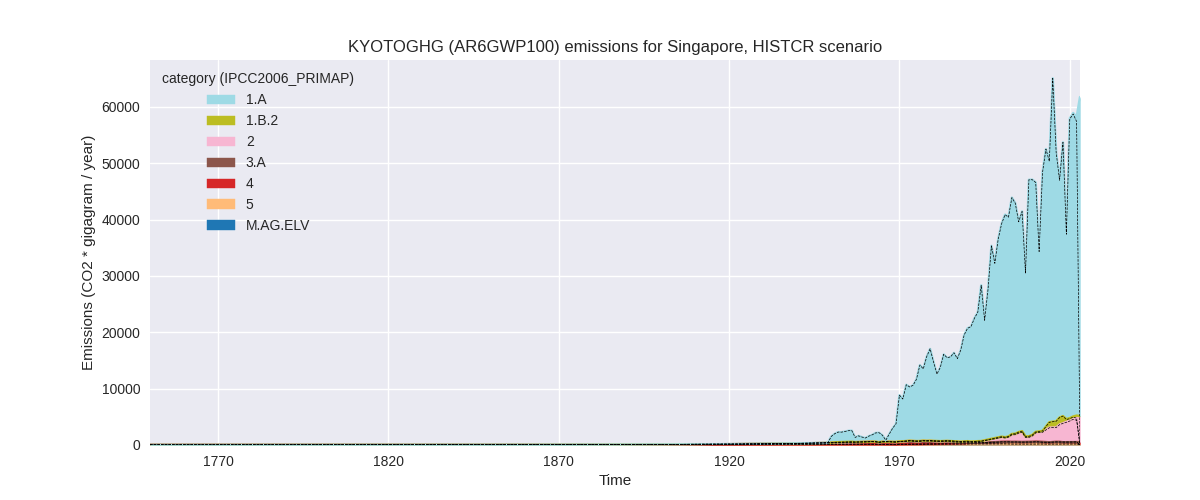

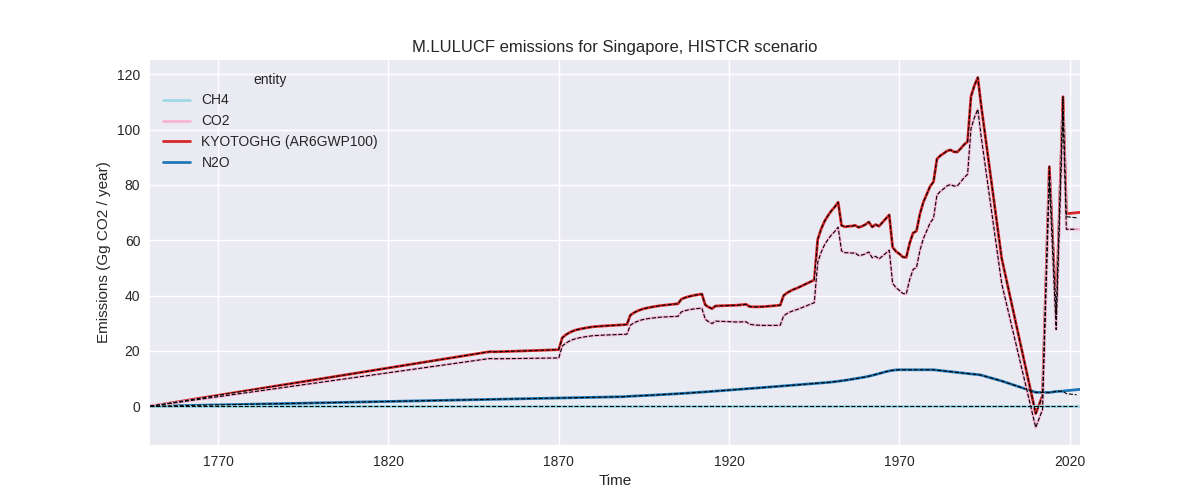
The following figures show the aggregate national total emissions excluding LULUCF AR6GWP100 for the third party priority scenario. The dotted linesshow the v2.5.1_final data.
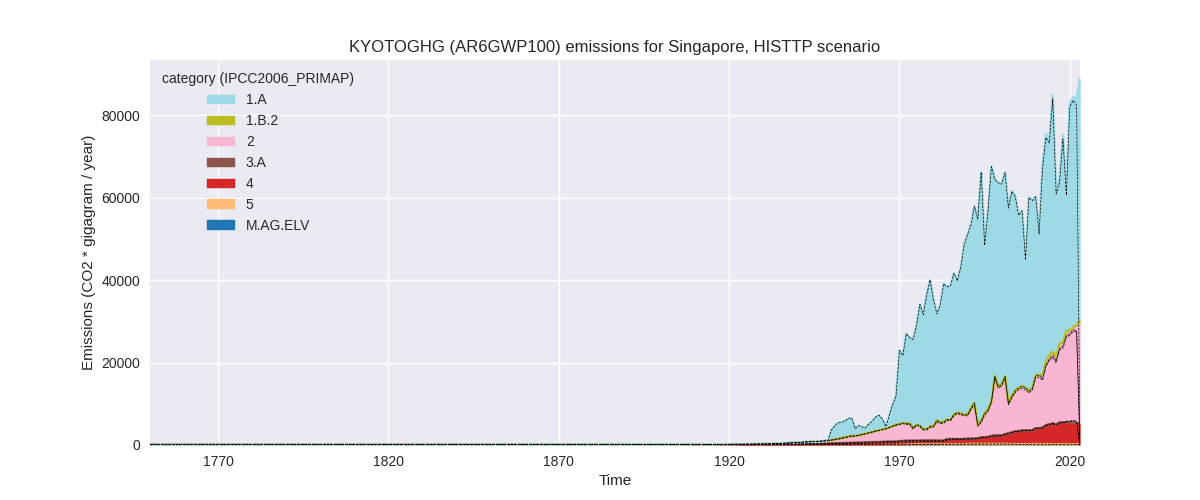
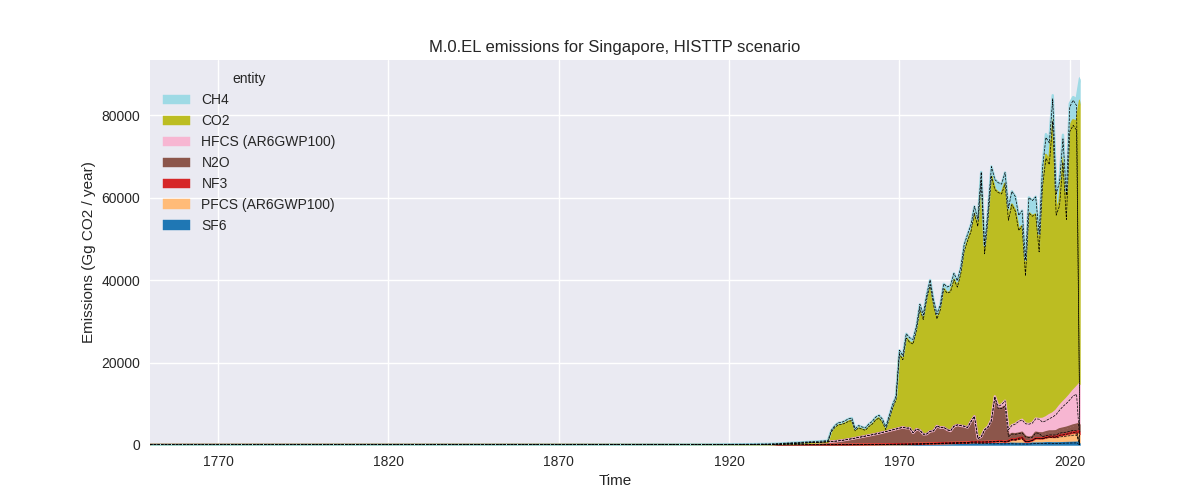
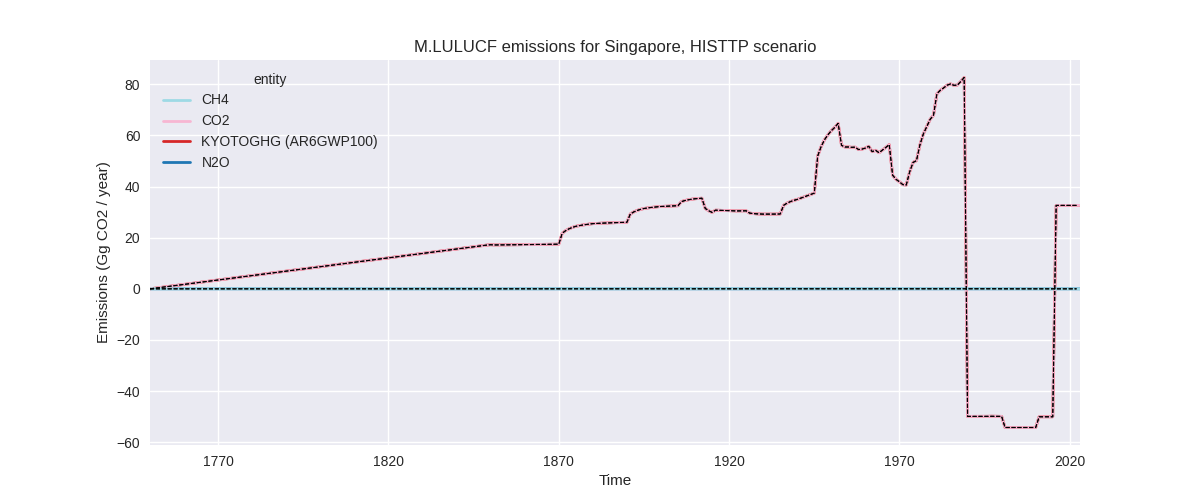
Overview over changes
In the country reported priority scenario we have the following changes for aggregate Kyoto GHG and national total emissions excluding LULUCF (M.0.EL):
- Emissions in 2022 have changed by 1.3%% (756.82 Gg CO2 / year)
- Emissions in 1990-2022 have changed by 0.1%% (37.88 Gg CO2 / year)
In the third party priority scenario we have the following changes for aggregate Kyoto GHG and national total emissions excluding LULUCF (M.0.EL):
- Emissions in 2022 have changed by 1.8%% (1517.90 Gg CO2 / year)
- Emissions in 1990-2022 have changed by 0.5%% (342.04 Gg CO2 / year)
Most important changes per scenario and time frame
In the country reported priority scenario the following sector-gas combinations have the highest absolute impact on national total KyotoGHG (AR6GWP100) emissions in 2022 (top 5):
- 1: 1.A, CO2 with 301.89 Gg CO2 / year (0.6%)
- 2: 2, NF3 with 237.77 Gg CO2 / year (51.5%)
- 3: 2, N2O with 163.98 Gg CO2 / year (159.9%)
- 4: 2, PFCS (AR6GWP100) with 37.52 Gg CO2 / year (2.0%)
- 5: 5, N2O with -30.82 Gg CO2 / year (-15.5%)
In the country reported priority scenario the following sector-gas combinations have the highest absolute impact on national total KyotoGHG (AR6GWP100) emissions in 1990-2022 (top 5):
- 1: 2, N2O with 15.01 Gg CO2 / year (46.2%)
- 2: 1.A, CO2 with 11.24 Gg CO2 / year (0.0%)
- 3: 2, NF3 with 7.21 Gg CO2 / year (4.2%)
- 4: 2, PFCS (AR6GWP100) with 1.14 Gg CO2 / year (0.1%)
- 5: 2, SF6 with 0.91 Gg CO2 / year (1.2%)
In the third party priority scenario the following sector-gas combinations have the highest absolute impact on national total KyotoGHG (AR6GWP100) emissions in 2022 (top 5):
- 1: 2, N2O with 1246.39 Gg CO2 / year (1215.0%)
- 2: 4, CH4 with -476.23 Gg CO2 / year (-8.8%)
- 3: 1.A, CO2 with 312.92 Gg CO2 / year (0.6%)
- 4: 2, NF3 with 237.83 Gg CO2 / year (51.5%)
- 5: 2, HFCS (AR6GWP100) with 125.58 Gg CO2 / year (1.4%)
In the third party priority scenario the following sector-gas combinations have the highest absolute impact on national total KyotoGHG (AR6GWP100) emissions in 1990-2022 (top 5):
- 1: 2, N2O with 321.16 Gg CO2 / year (15.9%)
- 2: 4, CH4 with -29.49 Gg CO2 / year (-0.9%)
- 3: 4, N2O with 13.26 Gg CO2 / year (30.0%)
- 4: 1.A, CO2 with 11.65 Gg CO2 / year (0.0%)
- 5: 2, NF3 with 7.21 Gg CO2 / year (4.2%)
Notes on data changes
Here we list notes explaining important emissions changes for the country. ’' means that the following text only applies to the TP time series, while means that it only applies to the CR scenario. Otherwise the note applies to both scenarios.
- No new country reported data was included for Singapore.
- Overall changes are below 1% and due to updated EI energy CO2 data.
- Because the latest year with country reported data is 2018 and some subsectors and gases in IPPU are not covered by EDGAR data the change in trend period for numerical extrapolation influences several sectors and gases for post 2018 in the CR scenario.
Changes by sector and gas
For each scenario and time frame the changes are displayed for all individual sectors and all individual gases. In the sector plot we use aggregate Kyoto GHGs in AR6GWP100. In the gas plot we usenational total emissions without LULUCF. ## country reported scenario
2022
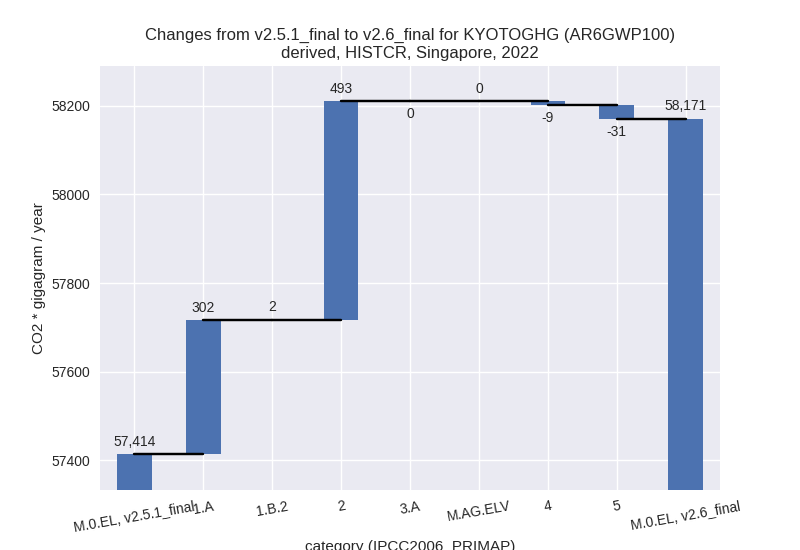
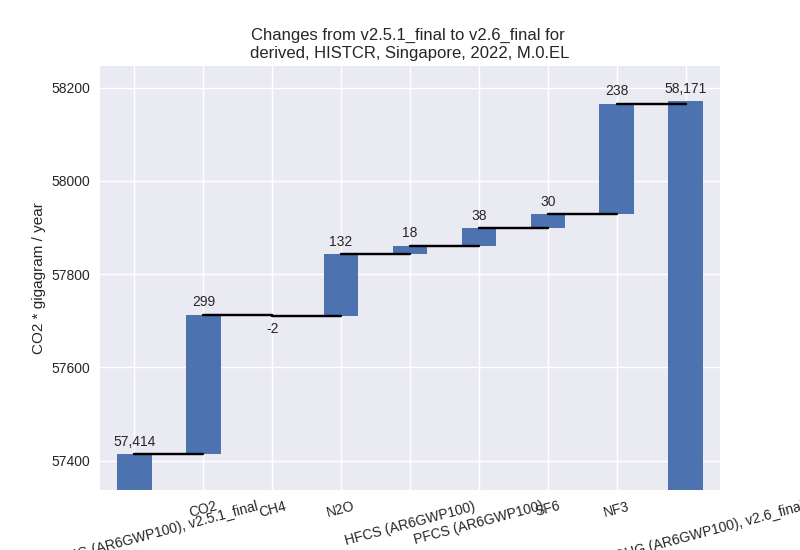
1990-2022
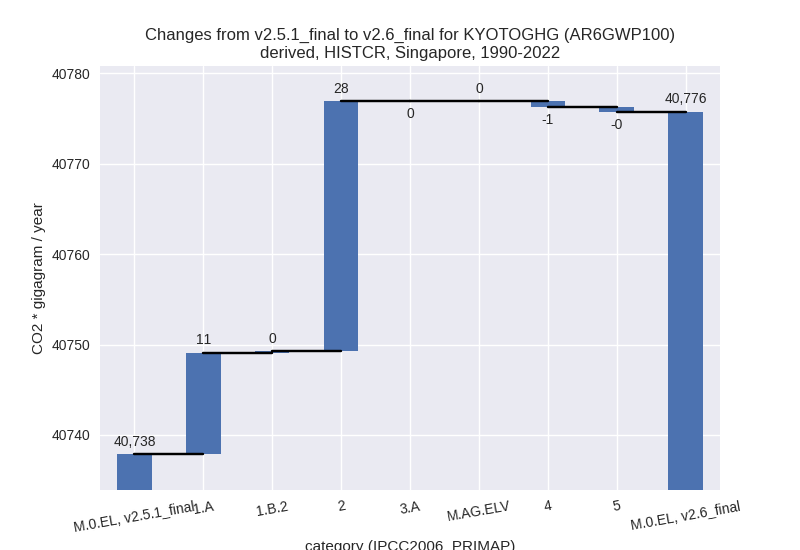
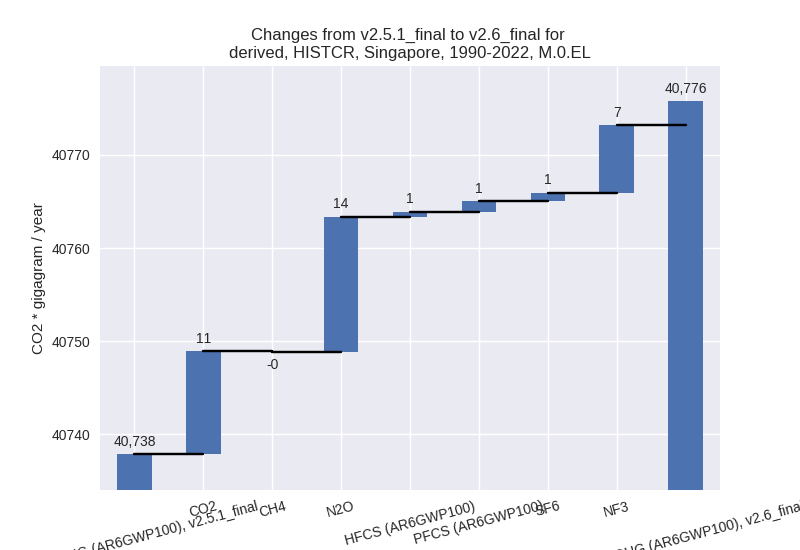
third party scenario
2022
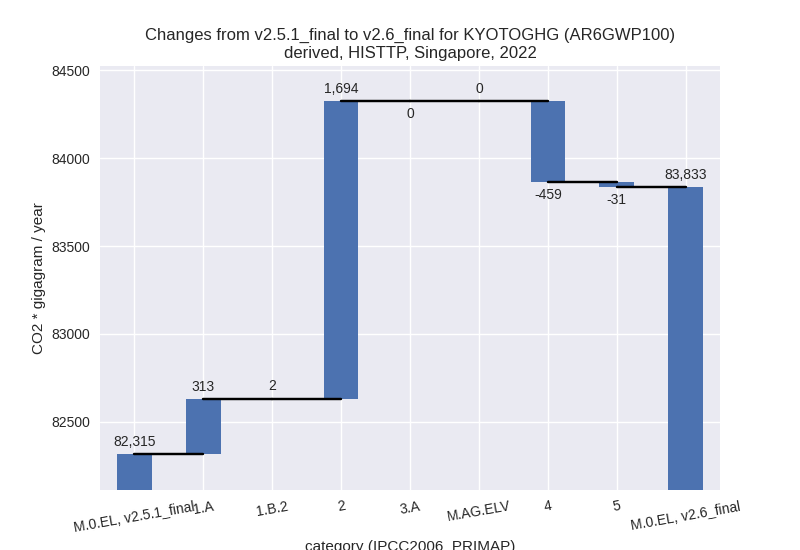
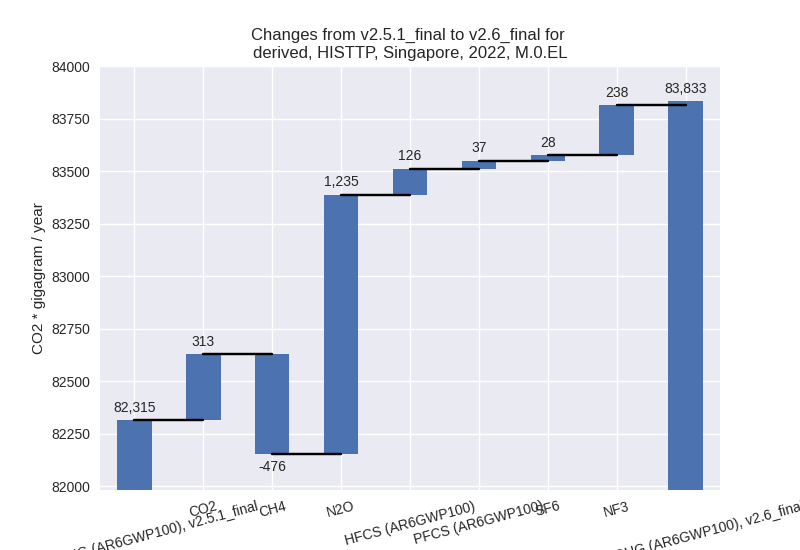
1990-2022
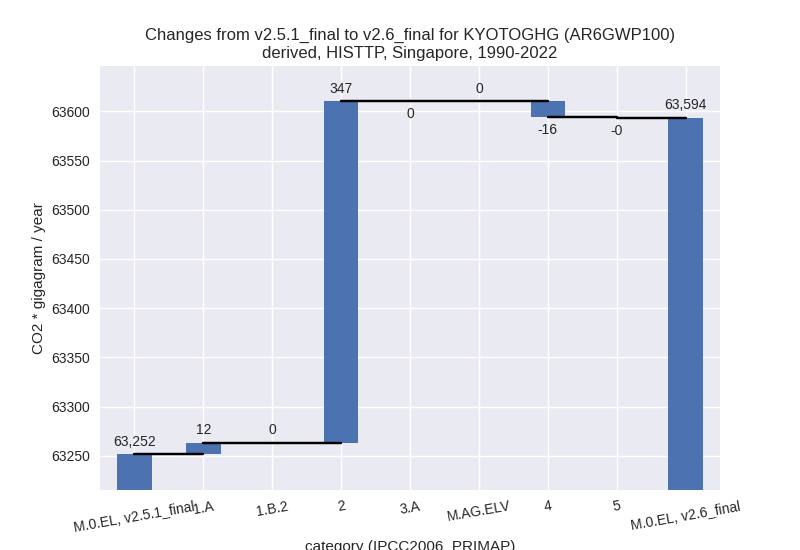
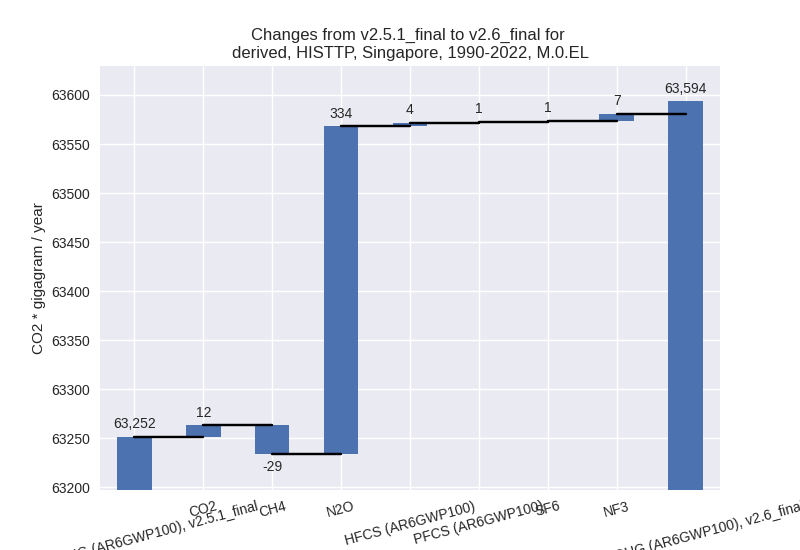
Detailed changes for the scenarios:
country reported scenario (HISTCR):
Most important changes per time frame
For 2022 the following sector-gas combinations have the highest absolute impact on national total KyotoGHG (AR6GWP100) emissions in 2022 (top 5):
- 1: 1.A, CO2 with 301.89 Gg CO2 / year (0.6%)
- 2: 2, NF3 with 237.77 Gg CO2 / year (51.5%)
- 3: 2, N2O with 163.98 Gg CO2 / year (159.9%)
- 4: 2, PFCS (AR6GWP100) with 37.52 Gg CO2 / year (2.0%)
- 5: 5, N2O with -30.82 Gg CO2 / year (-15.5%)
For 1990-2022 the following sector-gas combinations have the highest absolute impact on national total KyotoGHG (AR6GWP100) emissions in 1990-2022 (top 5):
- 1: 2, N2O with 15.01 Gg CO2 / year (46.2%)
- 2: 1.A, CO2 with 11.24 Gg CO2 / year (0.0%)
- 3: 2, NF3 with 7.21 Gg CO2 / year (4.2%)
- 4: 2, PFCS (AR6GWP100) with 1.14 Gg CO2 / year (0.1%)
- 5: 2, SF6 with 0.91 Gg CO2 / year (1.2%)
Changes in the main sectors for aggregate KyotoGHG (AR6GWP100) are
- 1: Total sectoral emissions in 2022 are 53328.94 Gg CO2 / year which is 91.7% of M.0.EL emissions. 2022 Emissions have changed by 0.6% (303.50 Gg CO2 / year). 1990-2022 Emissions have changed by 0.0% (11.39 Gg CO2 / year).
- 2: Total sectoral emissions in 2022 are 4335.81 Gg
CO2 / year which is 7.5% of M.0.EL emissions. 2022 Emissions have
changed by 12.8% (492.92 Gg CO2 /
year). 1990-2022 Emissions have changed by 1.8% (27.63 Gg CO2 / year). For 2022 the
changes per gas
are:
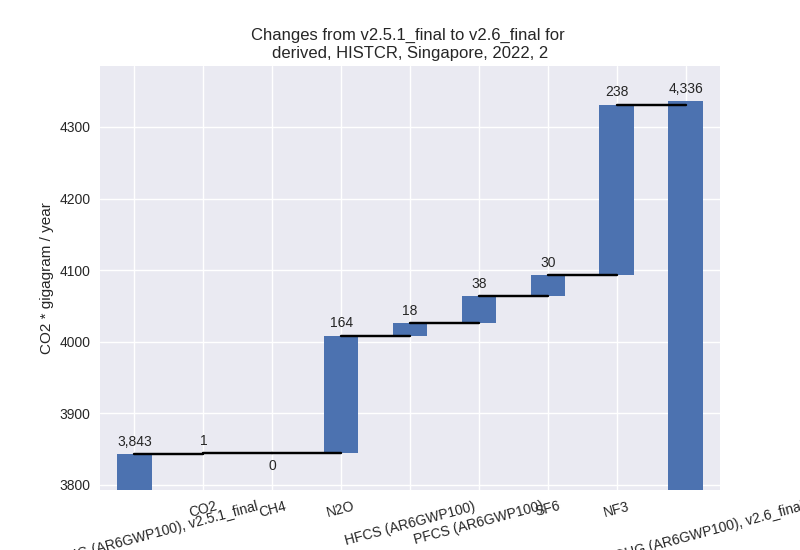
- M.AG: Total sectoral emissions in 2022 are 8.12 Gg CO2 / year which is 0.0% of M.0.EL emissions. 2022 Emissions have changed by 0.3% (0.03 Gg CO2 / year). 1990-2022 Emissions have changed by 0.0% (0.00 Gg CO2 / year).
- 4: Total sectoral emissions in 2022 are 329.32 Gg
CO2 / year which is 0.6% of M.0.EL emissions. 2022 Emissions have
changed by -2.6% (-8.81 Gg CO2 /
year). 1990-2022 Emissions have changed by -0.2% (-0.68 Gg CO2 / year). For 2022 the
changes per gas
are:
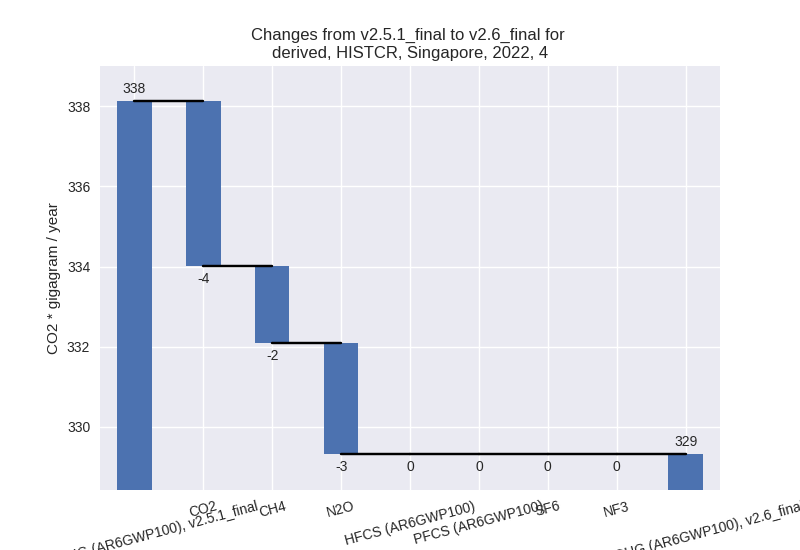
- 5: Total sectoral emissions in 2022 are 168.36 Gg
CO2 / year which is 0.3% of M.0.EL emissions. 2022 Emissions have
changed by -15.5% (-30.82 Gg CO2 /
year). 1990-2022 Emissions have changed by -0.2% (-0.47 Gg CO2 / year). For 2022 the
changes per gas
are:
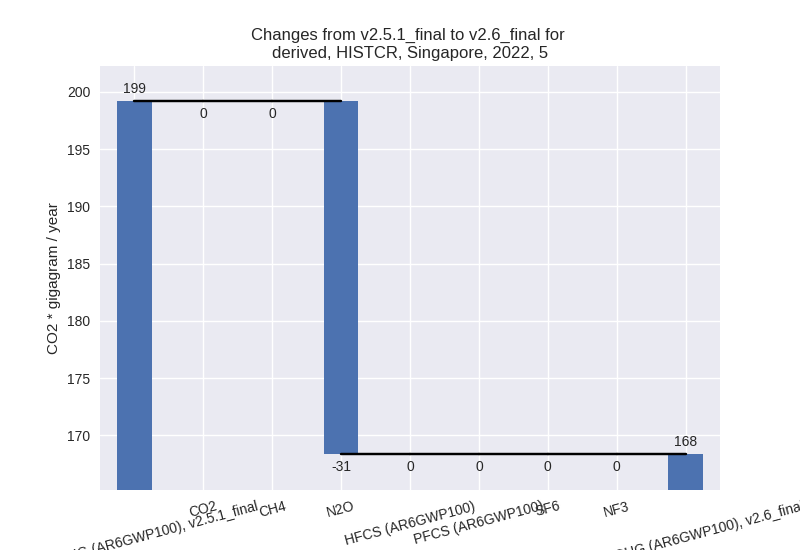
third party scenario (HISTTP):
Most important changes per time frame
For 2022 the following sector-gas combinations have the highest absolute impact on national total KyotoGHG (AR6GWP100) emissions in 2022 (top 5):
- 1: 2, N2O with 1246.39 Gg CO2 / year (1215.0%)
- 2: 4, CH4 with -476.23 Gg CO2 / year (-8.8%)
- 3: 1.A, CO2 with 312.92 Gg CO2 / year (0.6%)
- 4: 2, NF3 with 237.83 Gg CO2 / year (51.5%)
- 5: 2, HFCS (AR6GWP100) with 125.58 Gg CO2 / year (1.4%)
For 1990-2022 the following sector-gas combinations have the highest absolute impact on national total KyotoGHG (AR6GWP100) emissions in 1990-2022 (top 5):
- 1: 2, N2O with 321.16 Gg CO2 / year (15.9%)
- 2: 4, CH4 with -29.49 Gg CO2 / year (-0.9%)
- 3: 4, N2O with 13.26 Gg CO2 / year (30.0%)
- 4: 1.A, CO2 with 11.65 Gg CO2 / year (0.0%)
- 5: 2, NF3 with 7.21 Gg CO2 / year (4.2%)
Changes in the main sectors for aggregate KyotoGHG (AR6GWP100) are
- 1: Total sectoral emissions in 2022 are 55191.84 Gg CO2 / year which is 65.8% of M.0.EL emissions. 2022 Emissions have changed by 0.6% (314.53 Gg CO2 / year). 1990-2022 Emissions have changed by 0.0% (11.80 Gg CO2 / year).
- 2: Total sectoral emissions in 2022 are 23358.16 Gg
CO2 / year which is 27.9% of M.0.EL emissions. 2022 Emissions have
changed by 7.8% (1693.59 Gg CO2 /
year). 1990-2022 Emissions have changed by 2.9% (347.02 Gg CO2 / year). For 2022 the
changes per gas
are:
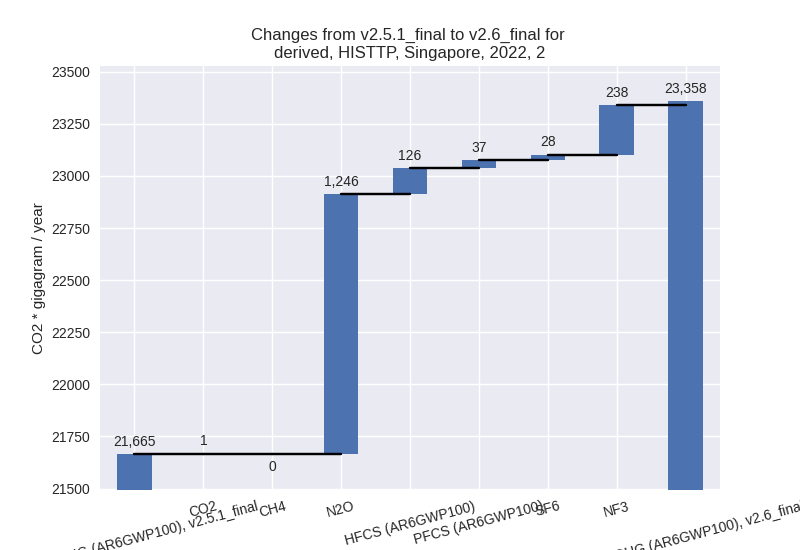
For 1990-2022 the changes per gas are: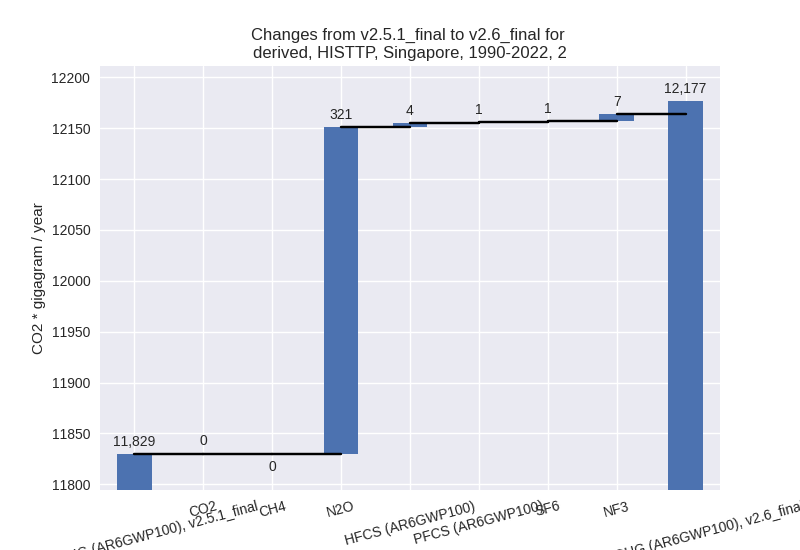
- M.AG: Total sectoral emissions in 2022 are 20.92 Gg CO2 / year which is 0.0% of M.0.EL emissions. 2022 Emissions have changed by 0.1% (0.03 Gg CO2 / year). 1990-2022 Emissions have changed by 0.0% (0.00 Gg CO2 / year).
- 4: Total sectoral emissions in 2022 are 5093.98 Gg
CO2 / year which is 6.1% of M.0.EL emissions. 2022 Emissions have
changed by -8.3% (-459.43 Gg CO2 /
year). 1990-2022 Emissions have changed by -0.5% (-16.31 Gg CO2 / year). For 2022 the
changes per gas
are:
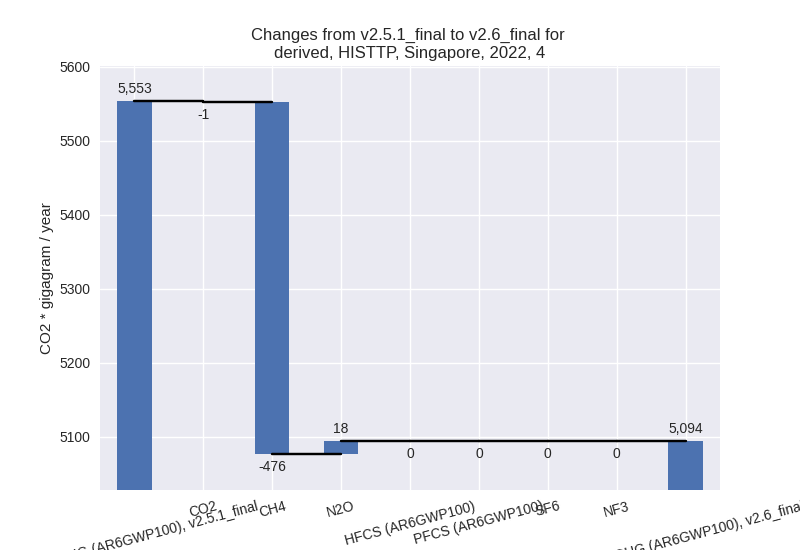
- 5: Total sectoral emissions in 2022 are 168.36 Gg
CO2 / year which is 0.2% of M.0.EL emissions. 2022 Emissions have
changed by -15.5% (-30.82 Gg CO2 /
year). 1990-2022 Emissions have changed by -0.2% (-0.47 Gg CO2 / year). For 2022 the
changes per gas
are:
